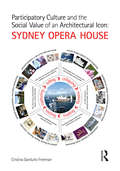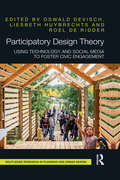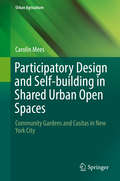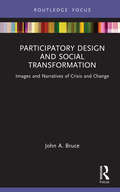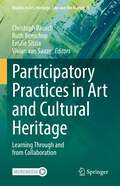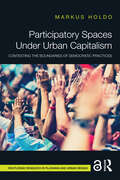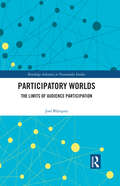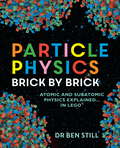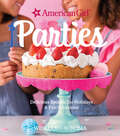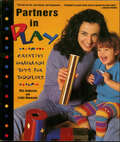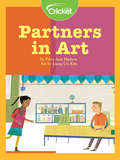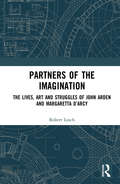- Table View
- List View
Participatory Culture and the Social Value of an Architectural Icon: Sydney Opera House
by Cristina Garduno FreemanThis book develops new and innovative methods for understanding the cultural significance of places such as the World Heritage listed Sydney Opera House. By connecting participatory media, visual culture and social value, Cristina Garduño Freeman contributes to a fast-growing body of scholarship on digital heritage and the popular reception of architecture. In this, her first book, she opens up a fresh perspective on heritage, as well as the ways in which people relate to architecture via participation on social media. Social media sites such as YouTube, Pinterest, Wikipedia, Facebook and Flickr, as well as others, become places for people to express their connections with places, for example, the Sydney Opera House. Garduño Freeman analyses real-world examples, from souvenirs to opera-house-shaped cakes, and untangles the tangible and intangible ways in which the significance of heritage is created, disseminated and maintained. As people’s encounters with World Heritage become increasingly mediated by the digital sphere there is a growing imperative for academics, professionals and policy-makers to understand the social value of significant places. This book is beneficial to academics, students and professionals of architecture.
Participatory Design Theory: Using Technology and Social Media to Foster Civic Engagement
by Oswald Devisch Liesbeth Huybrechts Roel De RidderIn recent years, many countries all over Europe have witnessed a demand for a more direct form of democracy, ranging from improved clarity of information to being directly involved in decision-making procedures. Increasingly, governments are putting citizen participation at the centre of their policy objectives, striving for more transparency, to engage and empower local individuals and communities to collaborate on public projects and to encourage self-organization. This book explores the role of participatory design in keeping these participatory processes public. It addresses four specific lines of enquiry: how can the use and/or development of technologies and social media help to diversify, to coproduce, to interrupt and to document democratic design experiments? Aimed at researchers and academics in the fields of urban planning and participatory design, this book includes contributions from a range of experts across Europe including the UK, Belgium, the Netherlands, Italy, Denmark, Austria, Spain, France, Romania, Hungary and Finland.
Participatory Design and Self-building in Shared Urban Open Spaces: Community Gardens And Casitas In New York City (Urban Agriculture Ser.)
by Carolin MeesThe book investigates the development of community gardens with self-built structures, which have existed as a shared public open space land use form in New York City’s low-come neighborhoods like the South Bronx since the 1970s. These gardens have continued to be part of the urban landscape until today, despite conflicting land use interests, changing residents groups and contradictory city planning. Both community gardens and self-built structures are created in a participatory design and self-built effort by urban residents and are an expression of the individual gardeners’ preferences, their cultural background and the decisions made by the managing residents’ group in regards to the needs of their neighborhood. Ultimately community gardens with self-built structures are an expression of the people’s will to commonly use this land for open and enclosed structures next to their homes in the city and need to be included in future urban planning.
Participatory Design and Social Transformation: Images and Narratives of Crisis and Change (Routledge Focus on Environment and Sustainability)
by John A. BruceParticipatory Design and Social Transformation introduces theories and methodologies for using image-oriented narratives as modes of inquiry and proposition toward greater justice and equity for society and the environment. Participatory artistic- and design-based research encounters – being, making, and learning with people, things, and situations – are explored through practices that utilize image-oriented and cinematic narratives. Collaborative alliances are invited to consider aesthetics, visuality, attunement, reflection, reciprocity, and care as a means for transdisciplinary approaches that foster generative and ethically responsible conditions toward collective liberation. The design of spectacles is proposed as a way for collective movements to affectively contribute to positive systemic changes from the ground up. In this way, Participatory Design and Social Transformation bridges contemporary advances in design theory and practice with media and art theory, the human and social sciences, and a pedagogy of interdependence. Participatory Design and Social Transformation will be of great interest to both professional and academic communities, providing resources for researchers, artists, designers, activists, students, educators, and leaders engaged with initiatives for transformation.
Participatory Practices in Art and Cultural Heritage: Learning Through and from Collaboration (Studies in Art, Heritage, Law and the Market #5)
by Christoph Rausch Ruth Benschop Emilie Sitzia Vivian Van SaazeThis edited volume analyzes participatory practices in art and cultural heritage in order to determine what can be learned through and from collaboration across disciplinary borders. Following recent developments in museology, museum policies and practices have tended to prioritize community engagement over a traditional focus on collecting and preserving museal objects. At many museal institutions, a shift from a focus on objects to a focus on audiences has taken place. Artistic practices in the visual arts, music, and theater are also increasingly taking on participatory forms. The world of cultural heritage has seen an upsurge in participatory governance models favoring the expertise of local communities over that of trained professionals. While museal institutions, artists, and policy makers consider participation as a tool for implementing diversity policy, a solution to social disjunction, and a form of cultural activism, such participation has also sparked a debate on definitions, and on issues concerning the distribution of authority, power, expertise, agency, and representation. While new forms of audience and community engagement and corresponding models for “co-creation” are flourishing, fundamental but paralyzing critique abounds and the formulation of ethical frameworks and practical guidelines, not to mention theoretical reflection and critical assessment of practices, are lagging.This book offers a space for critically reflecting on participatory practices with the aim of asking and answering the question: How can we learn to better participate? To do so, it focuses on the emergence of new norms and forms of collaboration as participation, and on actual lessons learned from participatory practices. If collaboration is the interdependent formulation of problems and entails the common definition of a shared problem space, how can we best learn to collaborate across disciplinary borders and what exactly can be learned from such collaboration?
Participatory Spaces Under Urban Capitalism: Contesting the Boundaries of Democratic Practices (Routledge Research In Planning And Urban Design Ser.)
by Markus HoldoCan people use new participatory spaces to reclaim their rights as citizens and challenge structures of political power? This book carefully examines the constraints and possibilities for participatory governance under capitalism. To understand what is at stake in the politics of participation, we need to look beyond the values commonly associated with it. Citizens face a dilemma: should they participate, even if this helps to sustain an unjust system, or not participate, thereby turning down rare opportunities to make a difference? By examining the rationale behind democratic innovation and the reasons people have for getting involved, this book provides a theory of how citizens can use new democratic spaces to challenge political boundaries. Connecting numerous international case studies and presenting original research from Rosario, Argentina, this book offers a crucial corrective to previous research. What matters most is not the design of new models of participation nor is it the supposed radical imagination of political leaders. It is whether people use new spaces for participation to renegotiate what democracy means in practice. Bridging critical urban studies and democratic theory, this book will be of interest to researchers and students in the fields of democratic innovations, political economy and urban planning. It will also provide activists and practitioners of participatory democracy with important tools to expand spaces of grassroots democracy.
Participatory Theatre and the Urban Everyday in South Africa: Place and Play in Johannesburg (Routledge Contemporary South Africa)
by Alexandra HalligeyThis book explores theatre and performance as participatory research practices for exploring the everyday of the city. Taking an inner-city suburb of Johannesburg, South Africa as its central case study, the book considers how theatre and performance might be both useful practical tools in considering the everyday city, as well as conceptual lenses for understanding it. The author establishes an understanding of space as ever evolving and formed through the ongoing relationship between things, human and non-human, and considers how theatre and performance offer useful paradigms for learning about and working with city spaces. As ephemeral, embodied, material artistic practices, theatre and performance mirror the nature of everyday life. The book discusses theatre and performance games and placemaking processes as offering valuable ways of discovering daily acts of place-making and providing insights that more conventional research methods may not allow. Yet the book also considers how seeing daily city life as a kind of performance, a kind of theatre in its own right, helps to further understandings of city spaces as ever evolving through complex webs of relationships. This book will be of interest to academics, academic practitioners and post-graduate students in the fields of theatre and performance studies, urban studies and cultural geography.
Participatory Worlds: The limits of audience participation (Routledge Advances in Transmedia Studies)
by José BlázquezThis book is an in-depth analysis of participatory worlds, practices beyond the mainstream models of content production and IP management that allow audience members to contribute canonically to the expansion of storyworlds, blurring the line between the traditional roles of consumers and producers. Shifting discussions of participatory culture and cross-media production and consumption practices to more independent media contexts, the book explores the limits, borders and boundaries of participating in today’s digital media storyworlds. The text examines how audience participation works, identifying opportunities to make it a meaningful practice for audiences and an asset for IP owners, and discussing the challenges and barriers that the application of participatory culture brings along. The book defines what meaningful participation is by introducing the concept of ‘intervention’ and explains a range of factors impacting the way in which participatory worlds and relationships between producers, audiences and the world are shaped. This volume will be of great relevance to media practitioners, scholars and students interested in transmedia storytelling, fandom, literary studies and comparative literature, new media and digital culture, gaming and media studies.
Particle Physics Brick by Brick
by Dr Ben StillUsing LEGO® blocks to create a uniquely visual and clear depiction of the way our universe is put together. This is the perfect introduction to the enigmatic and fascinating world of Quantum Physics.Our story starts with the Big Bang, and along the way, the constructs and interactions within and among atoms and sub-atomic particles, and the forces that play upon them, are clearly explained, with each LEGO® block representing a different atomic or sub-atomic particle. The different colours and size denote what that particle is and its relationship with the other 'building blocks'.Each chapter is presented in digestible chunks, using toy building blocks to illustrate the ideas and experiments that have led to some of the biggest discoveries of the past 150 years.Soon you'll be able to construct every element in the Universe using a box of LEGO® and this book!
Parties: Delicious Recipes for Holidays & Fun Occasions (American Girl)
by American GirlDial up the festivities—from Valentine’s Day to Halloween, summer barbecues to sleepovers—with recipes, party themes, and craft and decorating ideas. In this third cookbook from Williams Sonoma and American Girl, aspiring chefs will discover bite-sized delicacies like chocolate-dipped strawberries and butterfly-shaped cheese sandwiches, along with fare such as chicken-apple sausages on a stick, baked sweet potato fries, and caramel-dipped apple slices for holidays like 4th of July and Halloween, paired with clever serving ideas, fun theme-driven crafts, and colorful party favors. Sweet treats include s’mores ice cream sundaes, raspberry jam sandwich heart cookies, cinnamon-sugar monkey bread, peppermint brownie bites, hot chocolate cookies. Savory dishes features mac & cheese cups, grilled cheese hearts with tomato-star orzo soup, bite-sized broccoli-cheddar quiches, mini corn on the cob with lime butter, biscuit-wrapped veggie hot dog “mummies.” Refreshing drinks such as melon-mint agua fresca, spooky smoothies, milkshakes, and fruity “tea” will wet your whistle.The delicious recipes, fun ideas, and colorful images in American Girl Parties will captivate young cooks and can be made with everyday cookware and kitchen utensils; this companion title to American Girl Baking and American Girl Cooking will be a go-to resource for your little chef.
Partisan Canons
by Anna BrzyskiWhether it is being studied or critiqued, the art canon is usually understood as an authoritative list of important works and artists. This collection breaks with the idea of a singular, transcendent canon. Through provocative case studies, it demonstrates that the content of any canon is both historically and culturally specific and dependent on who is responsible for the canon's production and maintenance. The contributors explore how, where, why, and by whom canons are formed; how they function under particular circumstances; how they are maintained; and why they may undergo change. Focusing on various moments from the seventeenth century to the present, the contributors cover a broad geographic terrain, encompassing the United States, France, Germany, the Netherlands, Poland, Taiwan, and South Africa. Among the essays are examinations of the working and reworking of a canon by an influential nineteenth-century French critic, the limitations placed on what was acceptable as canonical in American textbooks produced during the Cold War, the failed attempt to define a canon of Rembrandt's works, and the difficulties of constructing an artistic canon in parts of the globe marked by colonialism and the imposition of Eurocentric ideas of artistic value. The essays highlight the diverse factors that affect the production of art canons: market forces, aesthetic and political positions, nationalism and ingrained ideas concerning the cultural superiority of particular groups, perceptions of gender and race, artists' efforts to negotiate their status within particular professional environments, and the dynamics of art history as an academic discipline and discourse. This volume is a call to historicize canons, acknowledging both their partisanship and its implications for the writing of art history. Contributors. Jenny Anger, Marcia Brennan, Anna Brzyski, James Cutting, Paul Duro, James Elkins, Barbara Jaffee, Robert Jensen, Jane C. Ju, Monica Kjellman-Chapin, Julie L. McGee, Terry Smith, Linda Stone-Ferrier, Despina Stratigakos
Partners In Play: Creative Homemade Toys For Toddlers
by Rita Anderson Linda NeumannPartners in Play is a book by written by author Rita Anderson.
Partners in Art
by Priya Ann MathewLeon's enthusiasm for art alienates him from his classmates. But he just might be the perfect person to encourage Nimmy, who thinks she lacks imagination.
Partners of the Imagination: The Lives, Art and Struggles of John Arden and Margaretta D’Arcy
by Robert LeachPartners of the Imagination is the first in-depth study of the work of John Arden and Margaretta D’Arcy, partners in writing and cultural and political campaigns. Beginning in the 1950s, Arden and D’Arcy created a series of hugely admired plays performed at Britain’s major theatres. Political activists, they worked tirelessly in the peace movement and the Northern Ireland ‘Troubles’, during which D’Arcy was gaoled. She is also a veteran of the Greenham Common Women’s Peace camp. Their later work included Booker-listed novels, prize-winning stories, essays and radio plays, and D’Arcy founded and ran a Woman’s Pirate Radio station. Raymond Williams described Arden as ‘the most genuinely innovative’ of the playwrights of his generation, and Chambers and Prior claimed that ‘The Non-Stop Connolly Show’, D’Arcy and Arden’s six-play epic, ‘has fair claim to being one of the finest pieces of post-war drama in the English language’. This study explores the connections between art and life, and between the responsibilities of the writer and the citizen. Importantly, it also evaluates the range of literary works (plays, poetry, novels, essays, polemics) created by these writers, both as literature and drama, and as controversialist activity in its own right. This work is a landmark examination of two hugely respected radical writers.
Party Animals: A Hollywood Tale of Sex, Drugs, and Rock 'n' Roll Starring the Fabulous Allan Carr
by Robert HoflerAllan Carr was Hollywood's premier party-thrower during the town's most hedonistic era--the cocaine-addled, sexually indulgent 1970s. Hosting outrageous soirees with names like the Mick Jagger/Cycle Sluts Party and masterminding such lavishly themed opening nights as the Tommy/New York City subway premiere, it was Carr, an obese, caftan-wearing producer--the ultimate outsider--who first brought movie stars and rock stars, gays and straights, Old and New Hollywood together. From the stunning success of Grease and La Cage aux Folles to the spectacular failure of the Village People's Can't Stop the Music, as a producer Carr's was a rollercoaster of a career punctuated by major hits and phenomenal flops--none more disastrous than the Academy Awards show he produced featuring a tone-deaf Rob Lowe serenading Snow White, a fiasco that made Carr an outcast, and is still widely considered to be the worst Oscars ever. Tracing Carr's excess-laden rise and tragic fall--and sparing no one along the way--Party Animals provides a sizzling, candid, behind-the-scenes look at Hollywood's most infamous period.
Party Origami: Instructions for 14 Party Decorations
by Jessica OkuiTransform beautiful origami paper into covetable party accents! With a booklet featuring step-by-step folding diagrams, eye-catching party props are just a few folds away. Origami enthusiasts and fans of pretty paper accents will enjoy folding chopstick rests, napkin rings, place settings, invitations, and more, in a range of colors and patterns.
Party Wall Disputes: The Party Wall etc. Act 1996 and Beyond - Legal Coherence, Disputes and Management
by Laura LintottAn accessible roadmap to the complexities of party wall disputes Party Wall Disputes: The Party Wall etc. Act 1996 and Beyond - Legal Coherence and Dispute Management meets the need for a roadmap to the main areas of law and fact relevant to party wall disputes: Statutes, including a detailed analysis of the Party Wall etc. Act 1996 and other relevant legislation,Property rights, such as rights of way, rights of support, drainage rights and rights linked to easements,Torts, such as nuisance related to noise and vibration and breaches of rights to light, andFactual matters, such as structural issues. In addition, this book maps out the available dispute management options under the Party Wall etc. Act 1996, in court as well as alternative dispute resolution methods (arbitration, mediation, medi-arb, expert determination and early neutral evaluation). The result is an invaluable resource for lawyers, party wall surveyors, construction professionals, academics and property owners who encounter or are interested in party wall disputes. “I can say with confidence that Dr Lintott has done the professions both of the law and of surveying in particular, as well as property owners, a great service in providing something of a stocktake…, where the tectonic plates of title, use of land, statute and common law, easements, planning and construction codes, rights, liabilities and obligations all meet. … She is mindful of the reality that party wall practice is ultimately driven by mutual proprietorial and essentially practical considerations …” —THE EARL OF LYTTON
Party in a Jar: 16 Kid-Friendly Jar Projects for Parties, Holidays & Special Occasions
by Vanessa Rodriguez CoppolaFun activities and perfect party favors for birthdays, holiday parties, and more!Party in a Jar features sixteen kid-friendly craft projects that not only provide entertainment for pint-sized partygoers but also function as take-home party favors. From edible dino terrariums to holiday-themed gifts and centerpieces, these upcycled jar crafts are earth-friendly and sure to be the hit of your next get-together! Try Bumblebee Dessert Jars • Patriotic Popcorn Jars • Space Nightlight Jars • Thankful Turkey Centerpieces • Snowman Candle Jars and more
Party of One: The Rise of Xi Jinping and China's Superpower Future
by Chun Han WongFrom one of the most admired reporters covering China today, a vital new account of the life and political vision of Xi Jinping, the authoritarian leader of the People's Republic whose hard-edged tactics have set the rising superpower on a collision with Western liberal democracies.Party of One: The Rise of Xi Jinping and China's Superpower Future shatters the many myths and caricatures that shroud one of the world's most secretive political organizations and its leader. Many observers misread Xi during his early years in power, projecting their own hopes that he would steer China toward more political openness, rule of law, and pro-market economics. Having masked his beliefs while climbing the party hierarchy, Xi has centralized decision-making powers, encouraged a personality cult around himself, and moved toward indefinite rule by scrapping presidential term limits-stirring fears of a return to Mao-style dictatorship. Today, the party of Xi favors political zeal over technical expertise, trumpets its faith in Marxism, and proclaims its reach into every corner of Chinese society with Xi portraits and hammer-and-sickle logos. Under Xi, China has challenged Western preeminence in global affairs and cast its authoritarian system as a model of governance worthy of international emulation.As a China reporter for the Wall Street Journal, Chun Han Wong has chronicled Xi's hardline strategy for crushing dissent and his political repression in Hong Kong and Xinjiang. Wong spent five years in Beijing before the Chinese government forced him to leave mainland China in 2019, after which he moved to Hong Kong and continued writing about Xi's leadership. Now, Wong has drawn on his years of first-hand reporting across China to create a lucid and historically-rooted account of China's leader, and how he inspires fear and fervor in his party, his nation, and beyond.Timely, revelatory, and important, Party of One explains how the future Xi imagines for China will reshape the future of the entire world.
Party of One: The Rise of Xi Jinping and China's Superpower Future
by Chun Han WongFrom one of the most admired reporters covering China today, a vital new account of the life and political vision of Xi Jinping, the authoritarian leader of the People's Republic whose hard-edged tactics have set the rising superpower on a collision with Western liberal democracies.Party of One: The Rise of Xi Jinping and China's Superpower Future shatters the many myths and caricatures that shroud one of the world's most secretive political organizations and its leader. Many observers misread Xi during his early years in power, projecting their own hopes that he would steer China toward more political openness, rule of law, and pro-market economics. Having masked his beliefs while climbing the party hierarchy, Xi has centralized decision-making powers, encouraged a personality cult around himself, and moved toward indefinite rule by scrapping presidential term limits-stirring fears of a return to Mao-style dictatorship. Today, the party of Xi favors political zeal over technical expertise, trumpets its faith in Marxism, and proclaims its reach into every corner of Chinese society with Xi portraits and hammer-and-sickle logos. Under Xi, China has challenged Western preeminence in global affairs and cast its authoritarian system as a model of governance worthy of international emulation.As a China reporter for the Wall Street Journal, Chun Han Wong has chronicled Xi's hardline strategy for crushing dissent and his political repression in Hong Kong and Xinjiang. Wong spent five years in Beijing before the Chinese government forced him to leave mainland China in 2019, after which he moved to Hong Kong and continued writing about Xi's leadership. Now, Wong has drawn on his years of first-hand reporting across China to create a lucid and historically-rooted account of China's leader, and how he inspires fear and fervor in his party, his nation, and beyond.Timely, revelatory, and important, Party of One explains how the future Xi imagines for China will reshape the future of the entire world.
Pasadena in Vintage Postcards
by Marlin HeckmanThe postcard has been a popular part of American communication for over a century, documenting both the interest of a place and its history. Captured here in nearly 200 vintage postcards is the unique history of this California town, translated in Chippewa as "Crown of the Valley." The City of Pasadena, just north of Los Angeles, sits against the majesty of the Sierra Madre mountain range. Incorporated in 1885, the city was originally known as a resort city, filled with tourists from all over the world. Showcased here through the use of the author's personal postcard collection are vintage images of Millionaires Row, the Tournament of the Roses Parade, the Mt. Lowe Railway, and the Alpine Tavern.
Paso Robles
by Paso Robles Pioneer Museum Andrea H. Hobbs Milene F. RadfordHalfway between Los Angeles and San Francisco, the historic town of Paso Robles became known for its abundance of hot mineral springs that brought relief from pain--first for the Salinan Indians, then for the Franciscan friars. As word of the springs' healing powers spread, hotels and bathhouses were built to accommodate the tourists who came seeking cures. The little community developed steadily after 1886, when the railroad arrived and town lots were auctioned. Area homesteaders raised cattle, grew grain, and planted fruit, walnut, and almond orchards--all without irrigation. Once known as the almond capital of the world, Paso Robles' agriculture has gradually changed from dry-land farms to irrigated vineyards. Tourists are attracted to Paso Robles for its mild climate, beautiful scenery, and mineral baths, which are being revived. The area's rich heritage is portrayed through more than 200 images from public and private historical collections.
Paso a paso (Fama): Prepárate a fondo para conseguir tu sueño
by González, Lola¿Te gustaría conquistar tu sueño y no sabes por dónde empezar? ¿Fantaseas a menudo con la idea de triunfar sobre los escenarios? ¿Eres fan del programa Fama ¡a bailar! y quisieras seguir el ejemplo de alguno de los concursantes más queridos? Si harías lo que fuera por conseguir tu sueño, descubre que el secreto para alcanzarlo se esconde en tu interior. Abre bien los ojos y aprende paso a paso: - a rentabilizar tus dudas y a conocer tus limitaciones. - a cuidar tu imagen para que sea perfecta en cualquier entrevista o casting. - a valorar la importancia del trabajo y a interiorizar que la pasión y la entrega son los valores necesarios para conseguir el éxito. - a ser autodisciplinado, a escuchar, a preguntar y a trabajar en equipo. Lola González, la directora de la escuela de Fama ¡a bailar!, el programa de superación personal y de baile de más audiencia de la televisión, te ofrece en Paso a paso los mejores consejos y las anécdotas más divertidas de la escuela, y todo lo que ha aprendido como profesional de la danza y como profesora en los últimos años. Un libro divertido en el que encontrarás las herramientas necesarias para hacer realidad tu sueño.
Pasolini
by Stefania BeniniPoet, novelist, dramatist, polemicist, and filmmaker Pier Paolo Pasolini continues to be one of the most influential intellectuals of post-war Italy. In Pasolini: The Sacred Flesh, Stefania Benini examines his corporeal vision of the sacred, focusing on his immanent interpretation of the Christian doctrine of the Incarnation and the "sacred flesh" of Christ in both Passion and Death as the subproletarian flesh of the outcast at the margins of capitalism.By investigating the many crucifixions within Pasolini's poems, novels, films, cinematic scripts and treatments, as well as his subversive hagiographies of criminal or crazed saints, Benini illuminates the radical politics embedded within Pasolini's adoption of Christian themes. Drawing on the work of theorists such as Ernesto De Martino, Mircea Eliade, Jean-Luc Nancy, Alain Badiou, Giorgio Agamben, and Slavoj Žižek, she shows how Pasolini's meditation on the disappearance of the sacred in our times and its return as a haunting revenant, a threatening disruption of capitalist society, foreshadows current debates on the status of the sacred in our postmodern world.
Pasolini Requiem: Second Edition
by Barth David SchwartzPier Paolo Pasolini (1922–75) was one of the most important Italian intellectuals of the post–World War II era. An astonishing polymath—poet, novelist, literary critic, political polemicist, screenwriter, and film director—he exerted profound influence on Italian culture up to his untimely death at the age of fifty-three. This revised edition of what the New York Times Book Review has called “the standard Pasolini biography” introduces the artist to a new generation of readers. Based on extensive interviews with those who knew Pasolini, both friends and enemies, admirers and detractors, Pasolini Requiem chronicles his growth from poet in the provinces to Italy’s leading “civil poet”; his flight to Rome in 1950; the scandalous success of his two novels and political writing; and his transition to film, where he started as a contributor to the golden age of Italian cinema and ended with the shocking Salò, or the 120 Days of Sodom. Pasolini’s tragic and still unsolved murder has remained a subject of contentious debate for four decades. The enduring fascination with who committed the crime—and why—reflects his vital stature in Italy’s political and social history. Updated throughout and with a new afterword covering the efforts to reopen the investigation—and the legal maelstrom surrounding Pasolini’s demise—this edition of Pasolini Requiem is a riveting account of one of the twentieth century’s most controversial, ever-present iconoclasts.
